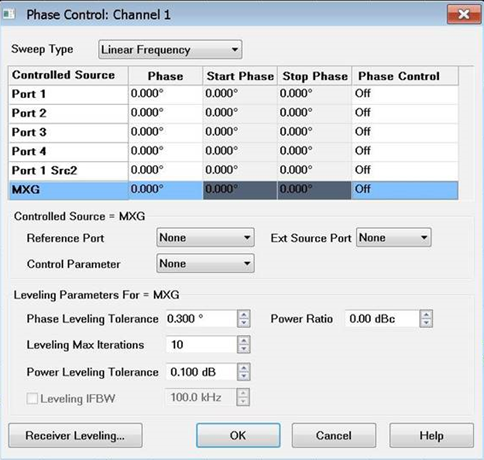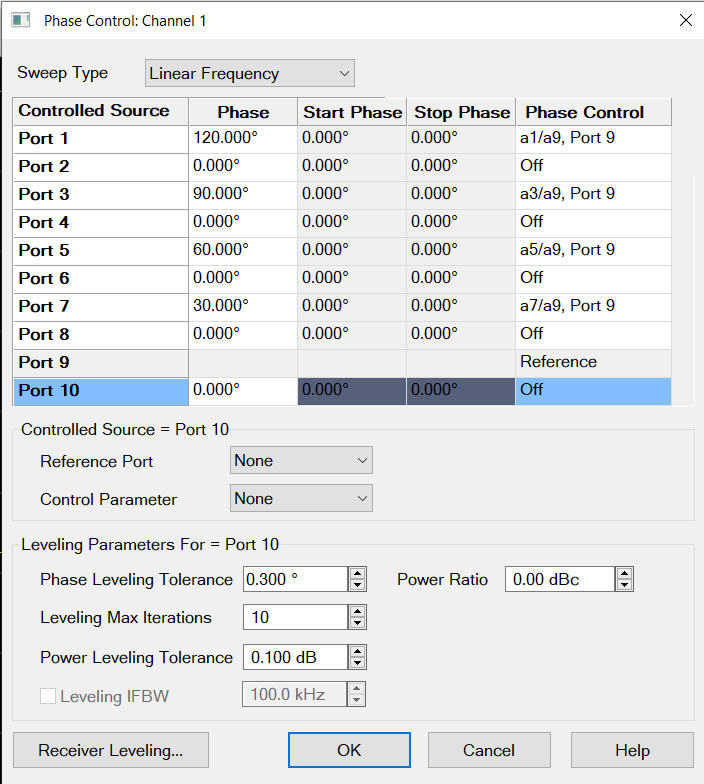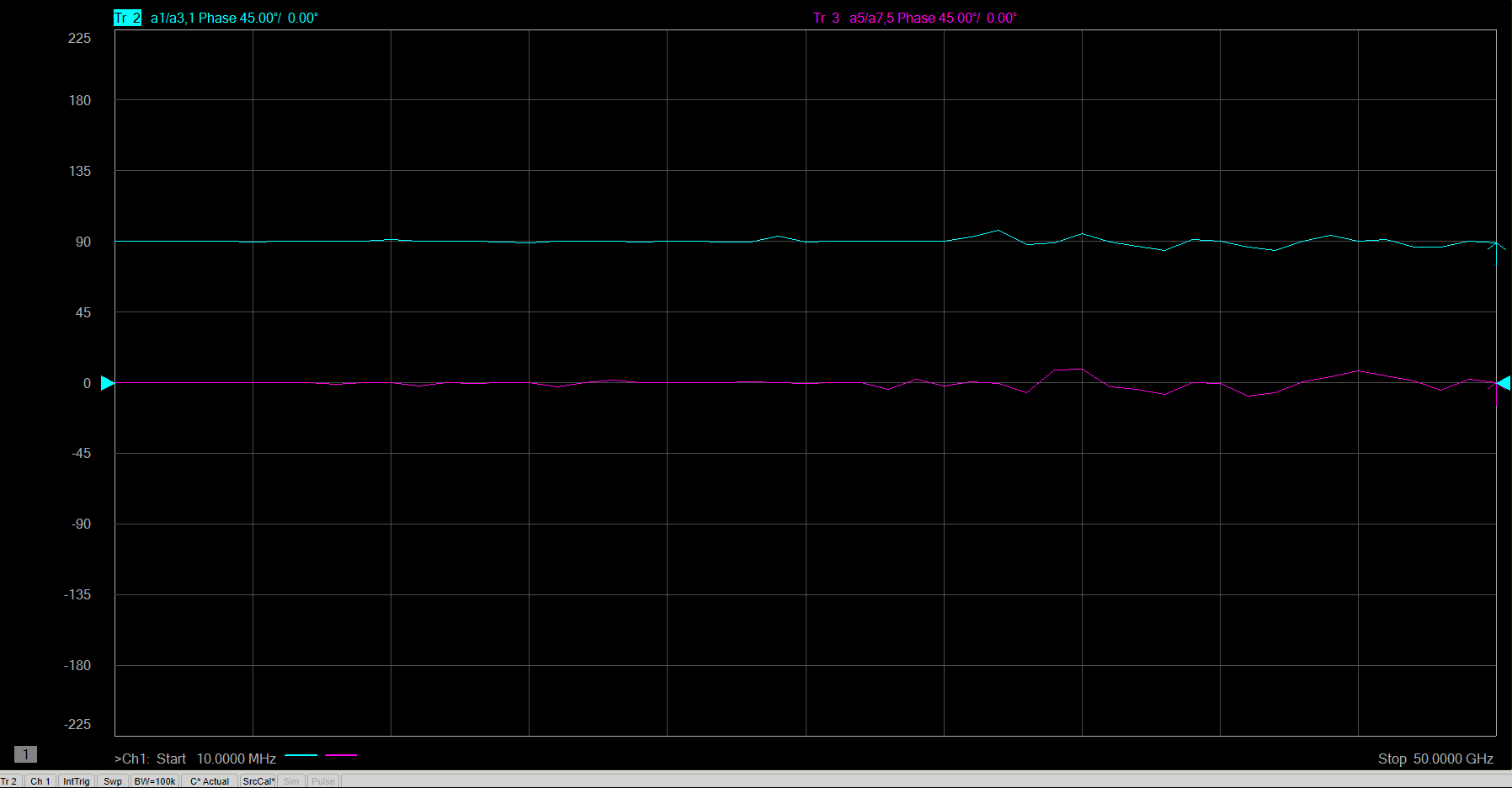Source Phase Control (Opt S9x088A/B)
Option S9x088A/B allows you to control the phase of a VNA source or an external source. Two sources are required.
See other 'Setup Measurements' topics
Overview
The Source Phase Control feature provides a specific phase difference between two sources. The phase difference can be fixed (for example, at 90 degrees), or swept between two arbitrary phase values (for example, from 0 to 360 degrees).
This feature is allowed on ALL PNA-X models, any N522x, E5080B, E5081A, M980xA, M983xA and P50xxA/B model with either two internal sources or an external source and configurable test set.
Any combination of VNA internal or external sources may be used. One source is selected as the controlled source and the other source is the reference source. You select the two sources by selecting the ports at which the sources are available. The choice of ports is limited for you on the Phase Control dialog. Learn about these limitations.
In addition to selecting source ports, you also select the receivers to be used to measure the phase for the sources. This can be test port receivers or the reference receivers for the specified source ports. The receivers measure the relative phase of the sources, then adjust the phase of the controlled source, then remeasure until the phase difference is within the tolerance that you specify.
Phase can also be set without using any receivers. This is called 'Open Loop' mode. In this mode, the phase of the controlled source is set once, and iterations are not done, resulting in phase that is less accurate and stable compared to using receivers to measure and set phase. Use Open Loop mode when you need to use the receivers to measure other parameters.
The phase of the controlled source can be swept relative to the reference source. The phase difference between the controlled and reference source is incremented and iterated on consecutive data points. Before starting the Phase Control dialog, select Sweep Type = Phase Sweep. Learn how.
When the phase of a source is controlled, the power of that source is also controlled using Receiver Leveling. Instead of the normal receiver-leveling mode where only one receiver is used, when phase control is active the ratio of two receivers is used to level the power of the controlled source. This is useful for making active load-pull measurements as described below. In Open Loop mode, neither the phase nor the power of the source is controlled.
Features and Limitations
-
Phase Control is allowed ONLY in a standard S-parameter channel.
-
Phase Control can be used with Wideband pulse measurements - NOT in narrow-band pulse mode.
-
Point Averaging is NOT allowed.
-
External sources are supported. Learn how to Configure an External Device. Phase can be controlled on Keysight MXG, PSG, ESG and EXG sources. The external source must be routed through the rear panel so that a reference receiver can measure its phase. Use the Path Configuration dialog to make switch settings and enable FOM mode.
-
Remote commands are available that allow the phase and power of each point to be set individually, much like in source power calibration. Use these commands if you need to create a specific pattern of amplitude/phase states, such as characterizing the load-pull of an amplifier.
Phase Control Use-Cases
Phase control and phase sweep is useful in the following applications:
Active load control
Provide a controlled, electronically-settable impedance to the output port of a DUT under fixed or swept-frequency conditions. Some examples are: measuring the gain and output power of an amplifier with a known load, and measuring the output from a directional detector with a known load.
The reference source is applied to the DUT input port, and the controlled source is applied to the DUT output port as a reverse input wave. The phase and power level of the controlled source is set relative to the forward output wave of the DUT (which is determined by the reference source), so that any arbitrary load impedance (gamma) can be set.
Optionally, the phase of the controlled source can be swept with a constant frequency, so that the phase of gamma rotates while the magnitude of gamma remains constant. The ratio of reverse input wave and forward output wave as viewed on a Smith chart or polar display would appear as a circle. This capability can be combined with external load-pull software to create traditional load-pull power contours.
Phase-controlled sources
Set the phase and magnitude of one source relative to a reference source, to provide differential, quadrature, or arbitrary phase-offset signals at a fixed or swept frequency. Typically, another instrument, receiver, or detector would be required to measure the response of the DUT.
How to make Phase Control settings:
|
|
Using Hardkey/SoftTab/Softkey
|
Using a mouse
|
-
Press Sweep > Main > Sweep Setup....
-
In the Sweep Setup dialog select Phase Sweep.
|
-
Click Stimulus.
-
Select Sweep.
-
Select Sweep Setup....
-
In the Sweep Setup dialog select Phase Sweep.
|
|
To perform a Phase Sweep:
|
-
Press Sweep > Main > Sweep Type.
-
Select Phase Sweep.
|
-
Click Stimulus.
-
Select Sweep.
-
Select Sweep Type....
-
In the Sweep Setup dialog select Phase Sweep.
|
|
To select (view) a Phase format: (Learn more)
|
-
Press Format > Format 1 > Phase.
|
-
Click Response.
-
Select Format.
-
Select Phase, Unwrapped Phase, or Smith.
|
|
To access the Phase Control dialog:
|
-
Press Sweep > Source Control > Phase Control.
|
-
Click Stimulus.
-
Select Sweep.
-
Select Source Control.
-
Select Phase Control....
|
|

|
|
Phase Control dialog box help
|
|

Sweep Type See Sweep Type for information.
Port N Select a port to set its phase control configuration. This is the 'controlled' port.
Phase Specify any Fixed Phase setting.
Start / Stop Phase Available when Sweep Type is set to Phase Sweep. Learn how. Enter the Start and Stop phase values in degrees.
Phase Control Click in the port cell to be controlled, then choose from the following:
-
Off - Phase is NOT set or controlled.
-
Open Loop - Phase is set, but receivers are NOT used to measure and iterate the phase or power of the source. Therefore, the setting of phase is not as accurate or stable. Open Loop mode can be used with phase sweep (for example, from 0 to 360 degrees). However, each sweep may not start at an absolute phase of 0 degrees. Settings made for phase control do not apply to an open loop sweep.
Note: Open loop mode works in AUTO mode using the Power and Attenuators dialog. Therefore, the source does not have to be set to ON.
-
<rec/rec>, reference port (Controlled) - Phase and power is measured and iterated to within the specified tolerance. The receivers, reference port, and iteration properties are specified below.
-
Reference is displayed to indicate the specified reference port. You can also perform receiver leveling on the reference source. Learn how.
Reference Port Select a source port to be used as a phase reference for the controlled port.
The two internal VNA sources are available ONLY at specific ports. These choices are limited for you on the Phase Control dialog. For example on a 4-port PNA-X, the possible port pairings are: 1/3, 1/4, 2/3, or 2/4. Port 1 can NOT be paired with Port 2, and Port 3 can NOT be paired with Port 4. Learn more about these limitations.
Ext Source Port Selects the source port that the external source is routed through. Displayed when an external source is selected as the active port.
Control Parameter Select the receivers to be used to measure the phase and power of the sources.
The swept phase or phase offset will be the difference between these two receivers. Use either standard notation (R1, A) or logical receiver notation (a1,b1). Learn more.
Select the receivers based on your application. You are responsible to make sure that your DUT configuration routes the signals of interest to the correct receivers. Otherwise, the phase will not be properly controlled. For example, if you select a configuration where Port 4 is the controlled source (measured by a4) and Port 1 is the reference source (measured by b4), both Port 4 and Port 1 must be connected and measured by the Port 4 (a4 and b4) receivers. This would typically be at your DUT output. See the Active Load Pull Example below.
Phase Leveling Tolerance When consecutive phase measurements of the same data point are within this value of each other, then the phase measurement is considered settled.
Leveling Max Iterations Sets the maximum number of background phase measurements to perform in order to achieve settling. If the phase is not sufficiently settled after these measurements, then the closest value is used.
Power Leveling Tolerance The source is considered leveled when each stimulus data point has achieved the power level +/- (plus or minus) this tolerance value.
Leveling IFBW Available only for VNA receivers. By default, the IFBW for the leveling sweeps is set to 100 kHz. Learn more about IFBW.
Power Ratio Power ratio value. This is the power offset between the two receivers in the control parameter. Displayed for all sweep types except Power Sweep.
Start/Stop Power Sets the start and stop power ratio values during a power sweep. Displayed when the Sweep Type is set to Power Sweep. This is the power offset between the two receivers in the control parameter.
|
|
Phase Control Setup dialog box help
|
|

Select a port to set its phase control configuration This is the 'controlled' port.
Referenced to Select a source port to be used as a phase reference for the controlled port.
The two internal VNA sources are available ONLY at specific ports. These choices are limited for you on the Phase Control dialog. For example on a 4-port PNA-X, the possible port pairings are: 1/3, 1/4, 2/3, or 2/4. Port 1 can NOT be paired with Port 2, and Port 3 can NOT be paired with Port 4. Learn more about these limitations.
Control Parameter Select the receivers to be used to measure the phase and power of the sources.
The swept phase or phase offset will be the difference between these two receivers. Use either standard notation (R1, A) or logical receiver notation (a1,b1). Learn more.
Select the receivers based on your application. You are responsible to make sure that your DUT configuration routes the signals of interest to the correct receivers. Otherwise, the phase will not be properly controlled. For example, if you select a configuration where Port 4 is the controlled source (measured by a4) and Port 1 is the reference source (measured by b4), both Port 4 and Port 1 must be connected and measured by the Port 4 (a4 and b4) receivers. This would typically be at your DUT output. See the Active Load Pull Example below.
Background Sweep Properties
Background sweeps are phase and power measurements that are made, but the results are not displayed. For each data point, when subsequent measurements are within the specified tolerance, that point is considered settled. If consecutive phase or power measurements of the same data point are NOT within the specified tolerance before the Max Iterations is reached, then one of the following messages are displayed:
-
Phase leveling warning: phase not settled.
-
Phase leveling warning: power not settled.
-
Phase leveling warning: phase and power not settled.
Apply Settings to All Ports When checked, the specified settings are used for all background sweeps for all phase-controlled ports. When cleared, the following three settings are specified independently for each port pair.
Use Leveling IFBW Available only for VNA receivers. By default, the IFBW for the leveling sweeps is set to 100 kHz. Learn more about IFBW.
Tolerance When consecutive phase measurements of the same data point are within this value of each other, then the phase measurement is considered settled.
Max Iterations Sets the maximum number of background phase measurements to perform in order to achieve settling. If the phase is not sufficiently settled after these measurements, then the closest value is used.
|
Calibration and Phase Control
Calibrate only those ports that are used for a phase control measurement. For example, if using ports 1 and 3 for phase control, then do NOT calibrate all four ports. If other ports are calibrated, then even ports 1 and 3 may not yield acceptable results.
After performing calibration, the phase is aligned and the power is accurate at the calibration plane.
Phase Control with N Sources (M980xA)
Phase Control features can turn on and control N sources in one sweep if all sources share one reference port.
If different reference port are used, there are multiple sweeps that each sweep has a unique reference port.
There are 2 examples for multiport M980xA models.
Example of N sources share one reference port with multiport M980xA models

Dialog above is an example of 5 modules M980xA configuration.
Port1, 3, 5, 7 are all use Port 9 as reference port. Phase differences are set to different numbers of 120,90,30, 0. Because all the sources use one reference port, all the sources are turned on in one sweep.
The measurement is like below. All the measurements are from one sweep.

Example of port pairs with different reference ports for multiport M980xA models

Dialog above is an example of 5 modules M980xA configuration.
Port1 is referenced to Port3 and Port5 is referenced to Port7.
Because two different reference ports, there are two phase control sweeps. The measurement is like below. The two traces are gotten from two sweeps.







